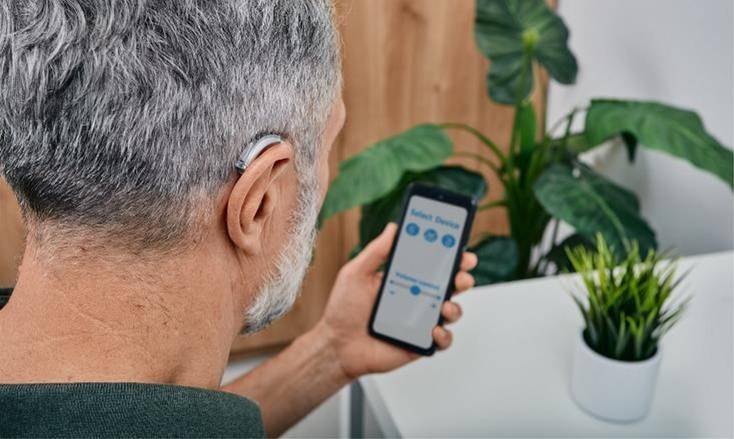
Answer:
There are three main types of hearing devices in the U.S. – prescription hearing aids, over-the-counter (OTC) hearing aids, and personal sound amplification products (PSAPs). There are pros and cons to each, as shown in the comparison table below. In short, all three can amplify sound, but only the first two are specifically for people with hearing loss and allow for improving hearing of specific ranges of frequencies.
Note that people with severe hearing loss who can neither hear nor discern conversation, as well as children and people who are cognitively impaired, should only consider prescription hearing aids. Also, it is best to be checked by a medical doctor before you decide on which type of hearing device to purchase, in order to rule out simple fixes (like earwax) or underlying medical issues that can be addressed, particularly if your hearing loss has come on recently, you’re having pain in your ear, hear ringing or buzzing, or you’re experiencing vertigo.
Hearing Aids & Devices Compared |
||
|
Device Type and Cost |
Pros |
Cons |
|
Prescription hearing aids Appx. $1,000 - $14,000 per pair |
Can boost sound more than a PSAP and have more targeted frequency-range boosts Fitted (including adjustments of frequencies) by professional audiologist Regulated as a medical device regarding performance and manufacture Suitable for adults and children |
Very expensive and may not be covered by insurance policies. Only available through an audiologist. |
|
Over-the-counter (OTC) hearing aids Costs range: $100 to $6,000 per pair |
May work as well as prescription hearing aids. No prescription. Regulated as a medical device regarding performance and manufacture. |
Not for severe hearing loss. Only for adults with mild to moderate hearing loss, suggested by: - Trouble hearing in noisy places or on the phone - Hard to follow speech in groups - Listening makes you tired - Need to turn up volume on TV or radio and others complain it’s too loud Available as preset or self-fitting. Preset devices are less expensive and easier to use, but self-fitting devices are more adjustable to one's hearing issues and are subject to more FDA scrutiny. Come in two basic shapes: behind-the-ear or in-the-ear. It's best to pick the shape you'll be most likely to wear, although behind-the ear may filter background noise better, have more capacity for features such as wireless audio streaming, and be easier to clean. Not suitable for people under the age of 18 |
|
Personal sound amplification products (PSAPs) Typically several hundred dollars per pair |
Amplify sound, and may include noise cancellation. Useful when listening to a lecture from a distant speaker or outdoors when birdwatching or hunting. No prescription. Relatively inexpensive. May include noise cancellation. Not regulated as a medical device, only as an electronic device. |
Cannot amplify as much as prescription or OTC hearing aid (limited to 20 dB of gain). Amplifying broad ranges of sounds, rather than specific frequencies. Not intended for people with hearing loss, but, in some situations, may work as well. |
|
Sources: Federal Register Rule on OTC Hearing Aids (8/17/22); The New York Times Wirecutter (Updated 4/17/23); NPR (8/16/22); Consumer Reports (4/20/23). |
||
OTC Hearing Aids
OTC hearing aids is the newest class of products. They are for people with mild to moderate hearing loss and first became available in the U.S. in October 2022. They are estimated to save the consumer over $2,800 per pair, largely because they are fitted and programmed (using an app) by the user, rather than by an audiologist. This savings is expected to make hearing aids more widely accessible, as many insurance policies, including Medicare, do not cover hearing aids, and those that do typically have deductibles, co-insurance, and/or co-payments.
There is evidence that self-fitted OTC hearing aids may be similar in effectiveness to the same hearing aid that is fitted by an audiologist for people with mild to moderate hearing loss. A study in South Africa among 64 people (average age 64) with self-reported mild to moderate hearing loss showed that those who used a self-fitted OTC hearing aid (Lexie Lumen by Lexie Hearing) for 6 weeks reported similar hearing aid benefit and speech-in-noise benefit (i.e., the ability to hear spoken words when background noise is present) as those who received the same hearing aid fitted by an audiologist who also fine-tuned it after the first 2 weeks. Those given the OTC hearing aid were provided with instructional material to help set up the device using the Lexie app and the option to contact remote support for adjustments or troubleshooting after the first 2 weeks (De Sousa, JAMA Otolaryngol Head Neck Surg 2023). Follow up with participants in this study 8 months after the initial fitting continued to show no significance difference between the groups in terms of overall hearing aid benefit, and the self-fitted group gave slightly higher scores than the audiologist-fitted group on satisfaction with the device (De Sousa, JAMA Otolaryngol Head Neck Surg 2024).
As more OTC hearing aids are investigated in clinical research, ConsumerLab will update this article with more product-specific information, including how the products compare to prescription devices. In the interim, you may want to read reviews of several existing products published by The New York Times Wirecutter (Updated September 17, 2025) or Consumer Reports (Updated March 16, 2025).
If you're considering an app-based hearing aid, be sure the app is compatible with your mobile device, e.g., some only work on iPhones.
Be aware that people with the following conditions should see a healthcare professional such as an ear-nose-throat doctor before getting an OTC hearing aid, as an OTC device may not be the best option for these individuals (FDA, 5-3-23):
- Difficulty hearing even if the room is quiet
- Difficulty hearing loud sounds
- Ear has a birth defect, unusual shape, or was injured or deformed in an accident
- Blood, pus, or fluid has come out of the ear within the last 6 months
- Ear feels painful
- Having ear wax or feeling like something is in the ear
- Dizziness or feeling a spinning (vertigo)
- Hearing changed suddenly within the last 6 months
- Hearing gets worse then gets better
- Hearing loss is worse in one ear
- Ringing or buzzing is heard in only one ear
PSAPs (personal sound amplification products)
It turns out that some PSAPs are just as good as a prescription hearing aid, while others are not, according to independent tests comparing the prescription hearing aid Oticon Nera 2 to the following PSAPs: Sound World Solutions CS50+, Soundhawk, Etymotic BEAN, Tweak Focus, and MSA 30X Sound Amplifier (Reed, JAMA 2017). (Note: Many of the PSAPs tested in this study are no longer available as of July 11, 2024).
In the study, 42 older men and women (average age 72) with mild to moderate hearing loss were tested for hearing accuracy with no hearing device and with each of the PSAPs and the prescription hearing aid. Among the personal sound amplification products tested, the Sound World Solutions CS50+ and Soundhawk were the most effective, with the researchers finding just 1 and 1.8 percentage point reductions in accuracy, respectively, compared to the Oticon Nera 2 prescription hearing aid. Two of the other PSAPs were 4 to 7 percentage points lower than Oticon Nera 2 in hearing accuracy, and one, MSA 30X Sound Amplified PSAP, which cost significantly less than other PSAP devices, came in much lower — just 65.3% accuracy.
Although there were some limitations to this study (i.e., the small number of participants and testing was conducted in a controlled environment, which may not represent all real-life auditory settings), the findings suggest that certain PSAPs offer a quality alternative to their costlier, prescription counterparts.
Join today to unlock all member benefits including full access to all CL Answers and over 1,400 reviews.
Join NowAlready a member? Sign In Here.
Join now at www.consumerlab.com/join/









Submit your comment
This feature is restricted to active members.
Join now to add comments and get all member benefits, including over 1,400 reviews.
Join NowAlready a member? Sign in here.